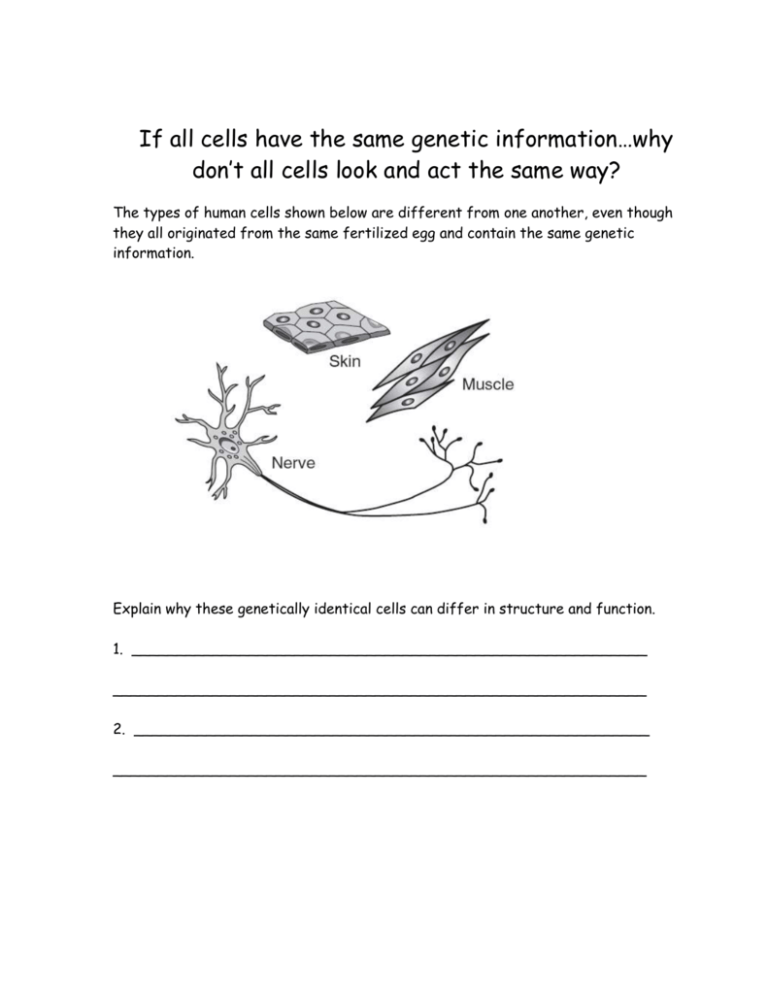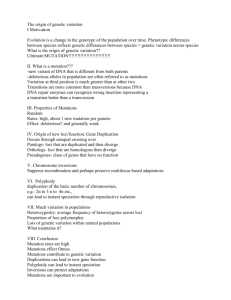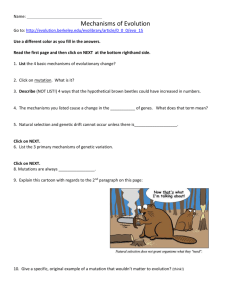If all cells have the same genetic information…why don`t all cells
advertisement

If all cells have the same genetic information…why don’t all cells look and act the same way? The types of human cells shown below are different from one another, even though they all originated from the same fertilized egg and contain the same genetic information. Explain why these genetically identical cells can differ in structure and function. 1. _________________________________________________________ ___________________________________________________________ 2. _________________________________________________________ ___________________________________________________________ Mutations What is a mutation? _________________________________________________________ Most mutations are _________________ and ________________. However, mutations also allow an organism to be more adaptable to a change in the environment. Mutations which occur in the body cells of sexually reproducing organisms CANNOT be passed on to the offspring, although they may result in disease or death for the organism involved. ONLY mutations which occur in sex cells or gametes can be passed to the offspring. Along with crossing over and genetic recombination, mutation provides for a source of variation in sexually reproducing individuals. Types of Mutations Gene Mutation Chromosomal Mutation Deletion: Extra Chromosome Insertion: Missing Chromosome Substitution: Change in Structure of a chromosome What Causes a Mutation? Mutations can be caused by randomly occurring mistakes during replication, mitosis and meiosis. Mutations can also be caused by environmental factors like radiation, ultra violet light and chemical exposure. Gene Mutation Examples I. Normal Hemoglobin: CTGAGTCCTGAGGAGAAGTCT mRNA: __________________________________________ Amino Acids: __________________________________________ Abnormal Hemoglobin: CTGAGTCCTGTGGAGAAGTCT mRNA: _________________________________________ Amino Acids: _________________________________________ Type of gene mutation: _____________________________________ Disease: ________________________________________________ II. Some gene mutations occur on genes found on the sex chromosomes and are called sex-linked mutations. The disease then shows up more frequently in males because they do not have two alleles for this trait. Color blindness and hemophilia are examples. Chromosomal Mutation Example The human cell has __________ chromosomes arranged in __________ pairs. Pairs 1through 22 are called ________________________________________ Pair 23 is called ___________________________________ and determines the sex of the individual. During Meiosis chromosomes may fail to separate causing a chromosomal mutation. Genetic Testing Genetic Counselors are professionals that use many genetic testing techniques to study the DNA of individuals. People who have a history of genetic diseases in their families may want to meet with a genetic counselor before getting pregnant to determine the likelihood of passing on a genetic disease to their unborn child. Tools for genetic testing: 1. Karyotype: An enlarged photograph of chromosomes that are arranged in pairs. Would this tool be more helpful for discovering gene mutations or chromosomal mutations? _______________________ Why? __________________ 2. Genetic Screening: Simple blood and urine tests that look at human DNA, RNA and proteins to look for symptoms of genetic diseases. Who would benefit from these tests? _____________________________________________________ _____________________________________________________ 3. Pedigree: A special family tree that shows a genetic disease and how it has been passed on. If this was a pedigree for a genetic disorder how many people in the family would show the symptoms of the disease? ________________ How many people are carriers of the disorder but do not have show symptoms of the disorder? ________________________________ Do you think this genetic disorder is dominant or recessive? Explain your answer. _____________________________________________________ 4. Amniocentesis: Amniotic fluid is the fluid surrounding the baby in the mother’s stomach and contains cells from the baby. During this test, fluid is withdrawn and can be used for karyotyping or chemical analysis. Why would a woman choose to have this test done? _____________________________________________________









